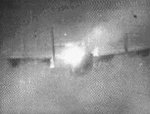A
Anonymous
Guest
I agree the MK108 was the premier anti-bomber weapon of the war. At the same time, it was very poor for fighter vs. fighter combat. The round starts flight at 1.5 mach and drops to sub-sonic flight before reaching 350 meters. Also the gun was prone to jamming and could not be fired under even mild G loads. It was ideal for frontal passes against heavy bomber formations, where velocity is not critical, and its 600 rpm RoF (impressive for a 30mm gun) was sufficent to ensure a high probability of scoring some hits.
2-5 hits (remember 1 in 4 rounds were duds) scored between the wing root and inboard engine assured a kill against a B-17, fewer hits were needed against a B-24. However, even this was not considered sufficent and a hydrostatically fused incendiary round with an AP cap was developed, which would only detonate when immersed in liquid. One such incendiary round to a fuel tank ensured destruction of the target.
=S=
Lunatic
2-5 hits (remember 1 in 4 rounds were duds) scored between the wing root and inboard engine assured a kill against a B-17, fewer hits were needed against a B-24. However, even this was not considered sufficent and a hydrostatically fused incendiary round with an AP cap was developed, which would only detonate when immersed in liquid. One such incendiary round to a fuel tank ensured destruction of the target.
=S=
Lunatic








